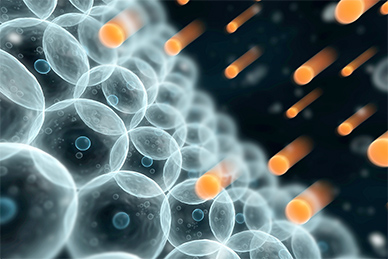- Professor Alexis Aspée started a research through a Fondecyt Project to establish the damage caused by free radicals within cells. His work could have significant effects on the pharmaceutical industry, as it would determine the compounds that may turn dangerous when exposed to sunlight.
The effect of free radicals on organisms has been widely spread by the cosmetic industry. However, there is still not enough information on how free radicals behave within cells or how the damage caused by their instability -due to an unpaired electron- progress in a chain effect, destroying the cell membranes.
Free radicals are molecules that are generated in chemical reactions and have a solitary unpaired electron. This makes them unstable and highly reactive, being able to modify cell membranes by attacking genetic material, like DNA. In the cosmetic industry, free radicals are related to skin ageing, what can be repaired by means of antioxidants.
However, Dr. Alexis Aspée, researcher at the Faculty of Chemistry and Biology, explained that there are still some issues that have to be solved in relation to the behavior of free radicals while they are within cells or macromolecules and to all what they destroy in their path.
Through the Fondecyt Project nº 1140240, “Photo-induced Free Radicals and Triplet Formation in the Organization of Biological Mimetic Systems”, Dr. Aspée is generating radicals in order to follow their path through molecules and study what elements near the radical are more prone to be affected by the damage caused by the loss of an electron.
“It is still difficult to understand how free radicals behave in a protein, if they can be repaired or if the damage they cause migrates to lipids and/or amino acids. We know the eventual damage, but at intermediate stages, there are still questions regarding what free radicals produce at a biological level in their path,” he explained.
Damage migration
The project was started in March 2014 and will last four years, including three stages. “What is interesting is to see how damage evolves and migrate, in a chain-effect, ‘stealing’ an electron from the inside of molecules or proteins. If we are able to understand damage behavior, we will have the key to reduce it or stop it,” he stressed.
The results of this study could have significant effects on pharmaceutical industry, as they would determine the compounds that change their behavior when they are exposed to sunlight, “to find out if some photosensitive drugs can turn harmful,” he concluded.
Translated by Marcela Contreras



